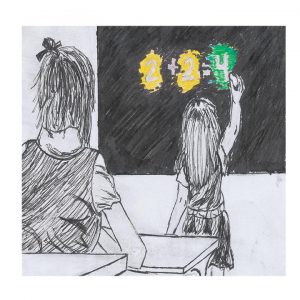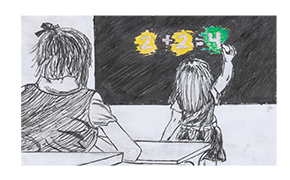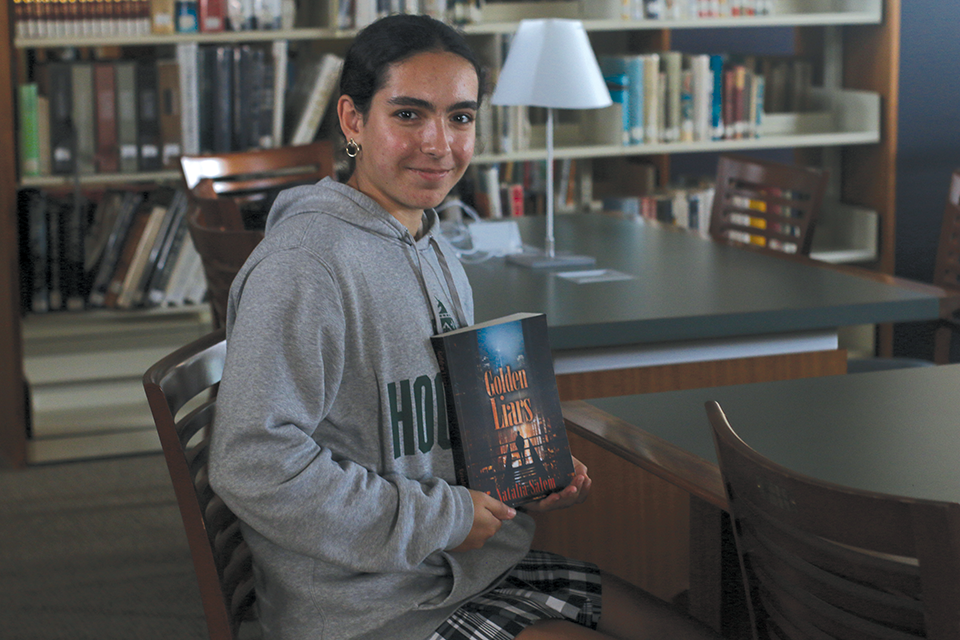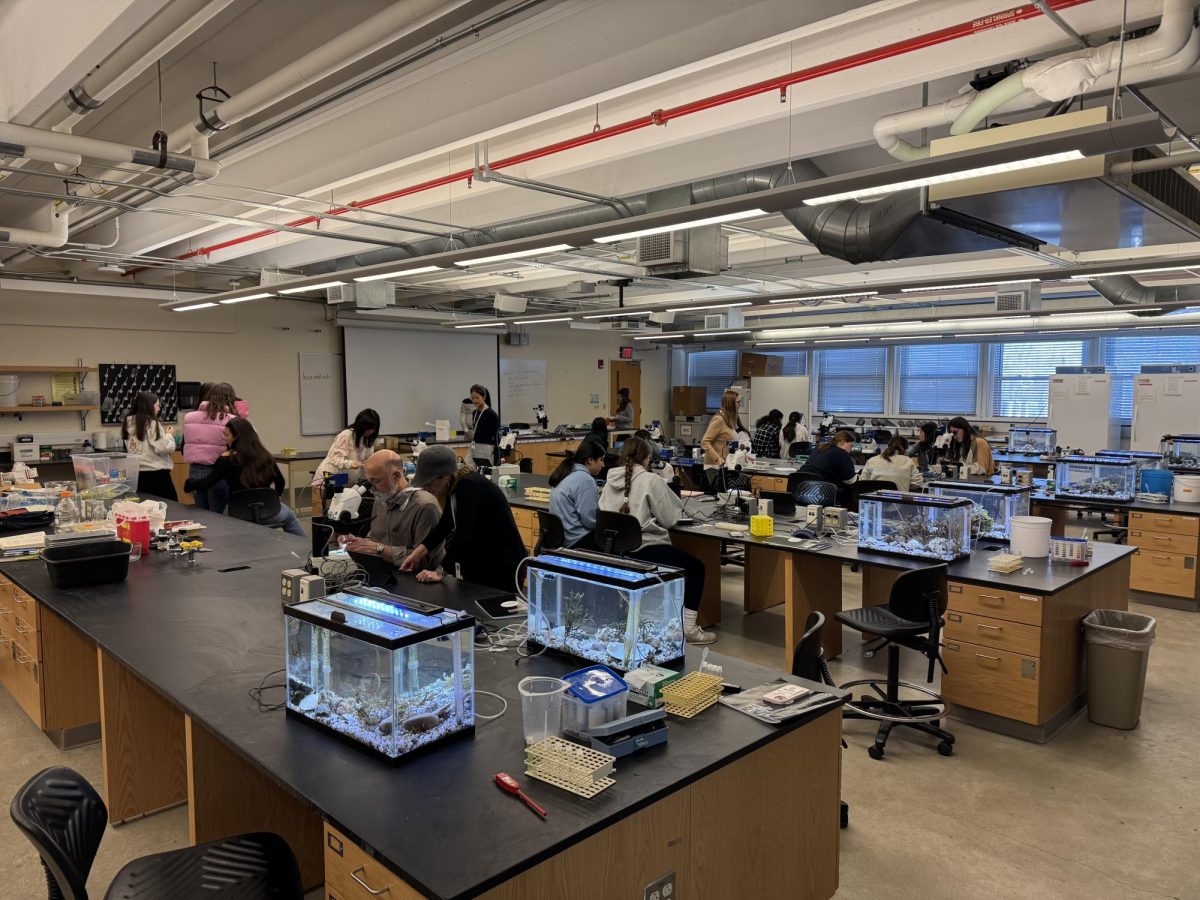Ever since childbirth, experiences revolve around the five senses: sight, smell, taste, touch and hearing. But what happens when these senses are affected? Managing Editor Inaara Padani interviews three Upper School students who have conditions that alter their senses.
Synesthesia

Junior Lydia Li has grapheme-color synesthesia, allowing her to associate single digits with various colors.
Credit: Inaara Padani
When junior Lydia Li sits down to take a math test, she doesn’t see the numbers on the page in black ink like most people do. Instead, she sees colors.
Li’s condition is called synesthesia—“an anomalous blending of the senses, in which the stimulation of one modality simultaneously produces sensation in a different modality,” according to scientificamerican.com.
Experiencing colors when presented with numbers or letters is a specific form of synesthesia called grapheme- color synesthesia. Although all synesthetes do not relate the same letters or numbers with the same colors, the association remains constant through an individual’s lifetime.
For example, Li always links zero with white, one with white outlined by a black border, two with bright yellow, three with light blue, four with dark green, five with red, six with light green, seven with dark blue, eight with brown and nine with black.
According to Li, these pat- terns developed due to her childhood experiences. “When I was younger, I always colored numbers in the same color because I thought they looked pretty,” Li said.
Additionally, she often played with LEGOs as a child, but it wasn’t until earlier this month while working with LEGOs for the Science Olympiad that Li discovered the similarities between the colors she sees and the colors of LEGOs.
In Kindergarten, Li attended a class in which she learned how to use an abacus, an ancient calculation tool.This was around the same time that she developed an affinity for LEGOs. Although Li discovered this condition herself during freshman year and has not been formally diagnosed with synesthesia, she believes that upbringing impacts the development of this condition.

Research indicates that synesthesia could be related to memory, learning and childhood development, but according to Psychology Today, the primary perspective of the cause of synesthesia is a mutation that leads to defective pruning between areas of the brain that are normally connected.
According to the American Psychological Association, one in 2,000 people have some form of synesthesia; however, the number is probably larger because many individuals are unaware of their condition.
In some cases, synesthesia can be beneficial as it is potentially linked to memory, but Li pointed out a disadvantage in regards to her condition.
“I think it hinders my concentration,” Li said. “It’s kind of distracting when I try to focus on numbers but not the color.”
On the other hand, Li said that synesthesia makes math more entertaining. She doesn’t mind telling others about her condition, describing it as “a fun topic to talk about” when introducing herself to others.
Anosmia
Last year, sophomore Lauren Hoang was diagnosed with anosmia, which is defined as the complete loss of smell.
“I never really realized I didn’t have [a sense of smell] until my parents kept alluding to things like when we’d pass by a bakery and nothing would change for me,” Hoang said.
Anosmia has various possible causes, the most common of which is nasal congestion from a cold, allergy, sinus infection or poor air quality. Other causes are head trauma, injury to the nose and smell nerves, exposure to toxic chemicals and use of certain medications. However, Hoang’s anosmia is something that she has experienced since birth, and she is unaware of the origin of her condition.
Hoang’s ability to smell is not the only sense impacted by her anosmia. This condition also interferes with her taste.
“I know I like to take things a lot saltier than a lot of people do,” Hoang said. “I also eat things based on texture; I like crunchy things. Chips don’t really taste like anything to me, but I just like eating chips because of the texture.”
Since Hoang has no frame of reference for what it’s like to smell, she doesn’t mind having this condition. Nevertheless, some unfavorable aspects associated with anosmia still exist.
“I feel kind of bad knowing that I’ll never be able to smell certain things,” Hoang said. “I read something that said smell is linked to memories a lot, so I feel kind of bad knowing that I probably won’t experience that sort of thing.”
Despite this, Hoang remains positive and does not allow her condition to interfere with her day-to-day life.
“Just because you can’t smell, you can’t see or you can’t hear, doesn’t mean that you’re worse
off than anyone else,” Hoang said. “It just means that you’re different, but you’re still equal.”
Stereo Blindness
Freshman Mackenzie Brabham has been playing tennis for five years. As a member of the varsity tennis team, she is well- equipped with the skills necessary to play the sport. How- ever, Brabham lacks stereopsis, which allows humans to determine distances between objects and see the world in three dimensions. While most people see everything in 3D, Brabham’s world is two-dimensional.
Last year, Brabham went to the eye doctor because she couldn’t see the board in class. It was then that she discovered her condition.
“I don’t know how to explain it to people because it just looks normal to me,” Brabham said.
Despite her lack of stereoscopic vision, Brabham is able
to go about her daily life without too much difficulty.
“There will be moments where I’ll try and put my phone on the table, and I’ll just miss,” she said.
Although wearing glasses and contacts can allow Brabham to get a glimpse of what it’s like to see in 3D, her condition was discovered too late, and it can’t be fixed completely. Nevertheless, Brabham remains engaged in the activities she loves.
“I play tennis, and I grew up and learned to play tennis with [stereo blindness],” Brabham said. “It can hurt me a little bit in sports, but it’s not too bad.”
For Brabham, this two-dimensional world is completely normal, although it may seem foreign to others.
“It’s out of the norm,” she said. “So, it’s kind of cool.”
– Inaara Padani



